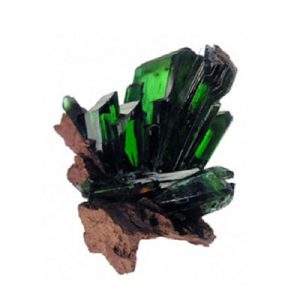Vivianite
Vivianite is an extremely rare gem mostly due to its difficulty of faceting. It is very soft, fibrous and somewhat flexible. It is a very attractive mineral specimen with vibrant colors. Vivianite is sometimes found inside fossil clam or snail shells or attached to fossil animal bone. Vivianite should be kept from long exposure to light as this can cause it to darken to nearly black. When found fresh the mineral may be colorless, or nearly colorless, and once exposed, will oxidize darkening to dark blue or blue-green. The darkening is from oxidation of the iron.
Vivianite is found in numerous localities, even for well-crystallized material. In England, from [Wheal Kind,] St. Agnes, and other mines in St. Just and Kea, Cornwall. At Hagendorf, Bavaria, Germany. From the Stari Trg mine, Trepca, Serbia. On the Taman Peninsula, Russia. Around Kerch, Crimean Peninsula, Ukraine. Huge crystals from Anloua, near Ngaoundéré, Cameroon. In the USA, from the Blackbird Mine, Lemhi County, Idaho; in the Treece and Ibex mines, Leadville, Lake County, Colorado; at the Bingham Canyon mine, Salt Lake County, Utah; from Richmond, Henrico County, Virginia; at the Foote mine, Kings Mountain, Cleveland County, North Carolina. In Mexico, from Santa Eulalia, Chihuahua. In Brazil, from the Énio pegmatite mine, northeast of Galiléia, Minas Gerais. Exceptional examples from Bolivia, at Poopo, Llallagua, Avicaya, Tazna, Monserrat, Morococala, Tatasi, and elsewhere. In the Ashio mine, Tochigi Prefecture, Japan.
| Chemical Formula: | Fe2+3(PO4)2 • 8H2O |
| Hydrated Iron Phosphate | |
| Molecular Weight: | 501.61 gm |
| Composition: | Iron | 33.40 % | Fe | 42.97 % | FeO |
| Phosphorus | 12.35 % | P | 28.30 % | P2O5 | |
| Hydrogen | 3.22 % | H | 28.73 % | H2O | |
| Oxygen | 51.03 % | O | |||
| 100.00 % | 100.00 % | = TOTAL OXIDE |
| Crystallography: | Monoclinic – Prismatic |
| Crystal Habit: | Prismatic crystals, to 1.3 m; flattened on [100] or [010], somewhat elongated along [100], many modifying forms, dominated by {100}, [010}, may be rounded or corroded; stellate groups, incrustations, concretionary, earthy, powdery. |
| Twinning: | Translation gliding T(010), t[001] |
| Cleavage: | Perfect on {010} |
| Fracture: | Fibrous |
| Tenacity: | Flexible, Sectile |
| Moh’s Hardness: | 1.5 – 2.0 |
| Density: | 2.60 – 2.70 (g/cm3) |
| Luminescence: | Not Fluorescent |
| Radioactivity: | Not Radioactive |
| Other: | Readily soluble in acids. Melting point = 1114°. Darkens in colour in H2O2. |
| Color: | Colorless, very pale green, with oxidation becoming dark blue, dark greenish blue, Indigo-blue, then black; colorless to blue in transmitted light |
| Transparency: | Translucent, Transparent |
| Luster: | Vitreous. Pearly on cleavages. Dull when earthy |
| Refractive Index: | 1.579 – 1.675 Biaxial ( + ) |
| Birefringence: | 0.0470 – 0.0730 |
| Dispersion: | Weak; r < v |
| Pleochroism: | Visible. X = blue, deep blue, Indigo-blue; Y = pale yellowish green, pale bluish green, yellow-green; Z = pale yellowish green, olive-yellow |
| Other: | The refractive indices increase with increasing oxidation, the birefringence decreases, and the pleochroism on {010} becomes stronger. |


